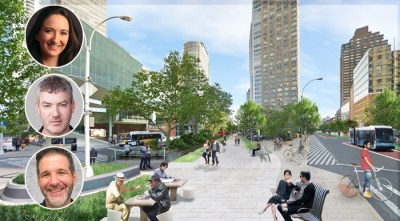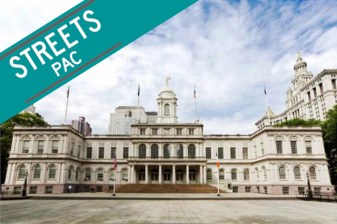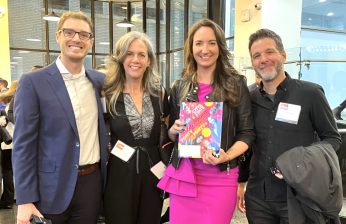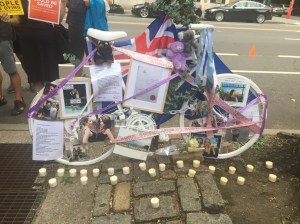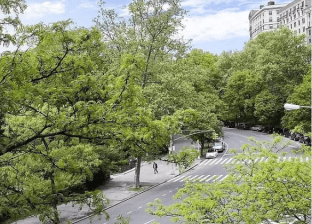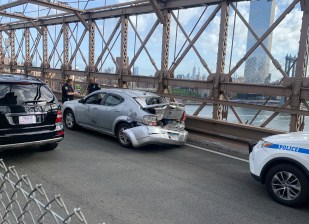Council Hopeful Champions a Pedestrianized Broadway in Manhattan Contest
Sara Lind runs on a plan to revive Upper West Side businesses with rezoning, street improvements and greenery.

A candidate for a City Council seat on Manhattan’s Upper West Side is making the issue of Broadway pedestrianization a central focus her bid.

Sara Lind, one of at least six candidates for the District 6 seat is basing her candidacy in part on a plan to stimulate an economic recovery on Broadway from 59th to 110th streets by pedestrianizing northbound lanes with dedicated lanes for bikes and buses (while providing space for deliveries and emergency vehicles). She’s also advocating a rezoning of the corridor from 73rd to 110th streets in order to encourage arts and theater uses, light manufacturing start-ups to make good like clothing on-site, ground-floor office space, food trucks, and mini-distribution hubs with restricted operating hours to remove idling trucks from local streets.
Amenities-wise, besides the dedicated bike and bus lanes, her plan envisions a combination of:
- Expanded the planted “Broadway Malls” at the center of the street for recreational space.
- Public greens spaces, seating and art installations.
- Year-round outdoor seating for neighborhood restaurants, bars and coffee shops.
The plan aims to rectify Broadway’s troubled retail situation, which featured shuttered businesses on many blocks even before the pandemic — partly because the wide and dangerous thoroughfare stymies foot traffic.
“We don’t need a highway running through our neighborhood,” said Lind, who for the past two years has headed the Broadway Task Force of Community Board 7, referring to the rank car sewer that substitutes for what should be the Upper West Side’s grand boulevard. “Creating a Broadway that people want to spend time on — with more pedestrian space, greenery and seating — will also help businesses. Making the street improvements will help the commercial situation.”
It also would improve safety in the district, which is an exceptionally dangerous place. In the four years between January, 2016 and December, 2019, there were 10,905 reported crashes — more than seven every day. Those crashes killed four cyclists, eight pedestrians and four motorists, and injured 2,141 people, including 402 cyclists, 570 pedestrians and 1,169 motorists. District 6 is now represented by Council Member Helen Rosenthal, who is term-limited. (Candidates to succeed her include Gale Brewer, Maria Danzilo, David Gold, Jeffrey Omura and Zach Weiner. Brewer is currently the Manhattan Borough President and is a former member of the council.)
Lind’s plan builds on decades of safe-streets activism along New York’s iconic thoroughfare. Advocates have long sought to eliminate cars between downtown Houston Street and Columbia University in Morningside Heights — and enjoyed some early progress under Mayor Bloomberg, when the city established a number of shared-street spaces and pedestrian plazas at Times, Herald, Madison and Union squares. The plazas gained a huge following among residents, businesses and tourists and rank among the city’s most popular destinations.
More recently, the city has proposed to make the 2.5-mile stretch of Broadway between Columbus Circle and Union Square “pedestrian friendly,” but that effort has been delayed because of the pandemic. The Union Square Partnership, a business-improvement consortium, recently released a plan to pedestrianize Broadway adjacent to the historic park of the partnership’s name.
Lind’s plan would, in effect, pick up above Columbus Circle, where those plans leave off. In particular, the six-block stretch of Broadway from 73rd to 79th streets represents low-hanging fruit for reclaiming public space from automobiles, which is why the Broadway task force has eyed its pedestrianization for years. A local group, Streetopia Upper West Side, demonstrated what such a pedestrianized Broadway would look like during a day-long “Celebrate Broadway” event in 2019.
That’s how calm we want our Upper West Side streets to be. Sweet dreams of space for people, little one. #CelebrateBroadway pic.twitter.com/ba0BSmxQyR
— Streetopia Upper West Side (@StreetopiaUWS) September 21, 2019
Verdi Park — at the confluence of Broadway, Amsterdam Avenue and 72nd Street — prevents northbound cars from driving directly uptown on Broadway anyway. Motorists who want to drive on Broadway must travel on Amsterdam and then turn left on a westbound street before turning right to get back onto Broadway — a maneuver that many don’t find worth the effort, so most traffic remains on the wider Amsterdam.
Car ownership is also low on the Upper West Side — where about three-quarters of households do not own a vehicle. The M104 Bus and the Broadway IRT constitute the main forms of transportation.
Lind hopes to work with landlords and community groups in order to develop a special arts district along Broadway anchored in the south by Lincoln Center, which lies just above Columbus Circle, and extending northward to the Beacon Theater, a prime music venue at 76th Street and the performing arts mecca Symphony Space at 94th Street. In it, she sees minority- and women-owned business, galleries, arts markets, co-working spaces, and “pop ups” like the Columbus Circle Holiday Market.
“I’m prepared to work with all stakeholders,” said Lind, a lawyer and political organizer who for several years directed 21 in ‘21, a group intent on electing at least 21 women to the 51-member New York City Council in 2021. She added that issues such as pick-ups and drop-offs for apartment buildings and events venues are “totally solvable,” as the experience of the theaters in pedestrianized Times Square shows. “We’ve seen success with plans like this across the city,” she said.
